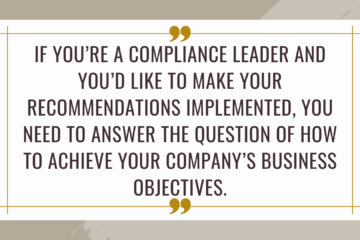FinTech Compliance Must Shift From Gap Analysis to Cost Benefit Analysis
Gap Analysis is a terrible and most inefficient approach to assess any FinTech compliance project.
You may be thinking: “Wait, what? Isn’t it how you are supposed to start your compliance analysis..?”
Well, yes, we all were indoctrinated to believe and act that way, this is what all compliance gurus have been telling us for the last 20+ years.
However, just think about it… Business projects are very similar to relationships.
If you were to go on a first date with someone new, would you judge them or only assess them based on a pre-defined checklist of what they must be or have in terms of looks, height, education, age, income, the books they read, political views?
Or would you rather gradually let yourself discover what this relationship opportunity could become, the potential of it?
Would you want yourself to be judged by your date based on the things you most of the time cannot change anyway?
Obviously not, because with these heavy upfront expectations your future will be doomed from the get-go. Heavy and rigid criteria will likely kill any potential for a new opportunity to grow.
To create anything new, it is important to see the uniqueness and the benefits of the new project, to assess the benefits instead of judging and projecting what can go wrong.
This is exactly what many FinTech Compliance officers are doing wrong: they know how to assess the gaps and what is missing, but they do not know how to assess and present the benefits of their recommendations being implemented.
They would say “We will be compliant and follow the law” – but it is not enough.

We can probably all agree that the past performance or past history or your legacy are not representative of what things can become in the future. Why? Because past risks and circumstances are different from current risks!
The problem with trying to judge a new opportunity using criteria from the past is that you will be biased or influenced by past results, right?
Both, compliance and business, have their instinctive biases.
The priority list of your business leaders probably looks like this:
- let’s get more customers and more revenues first,
- try to control and optimize costs,
- we can now afford to think how to keep our house in order.
The compliance priorities will likely have a very different order:
- let’s fix all past errors and gaps,
- then we can carefully study and research new opportunities,
- only once we have sufficient clarity, we can add and handle new risks.
If these biases are not reconciled, any new project within your FinTech company is doomed, because it is bound to repeat all the legacy issues and past mistakes.
If you are ready to overcome these biases and want to learn how to assess any new FinTech compliance project in a balanced way by applying the cost-benefit analysis, you must absolutely join this 60-minute FREE training on January 16th, 2024! It will give you all the tools you need to define compliance requirements and assess the risks of new projects without exhausting gap analysis torture and without having to fix all past issues first!
At the end of this training, you will walk away with a simple step-by-step new project assessment guide and will learn how to use the ROI method to present the compliance requirements using the cost-benefit analysis instead of the gap analysis, so that your business stakeholders immediately understand what is needed and what is at stake.



